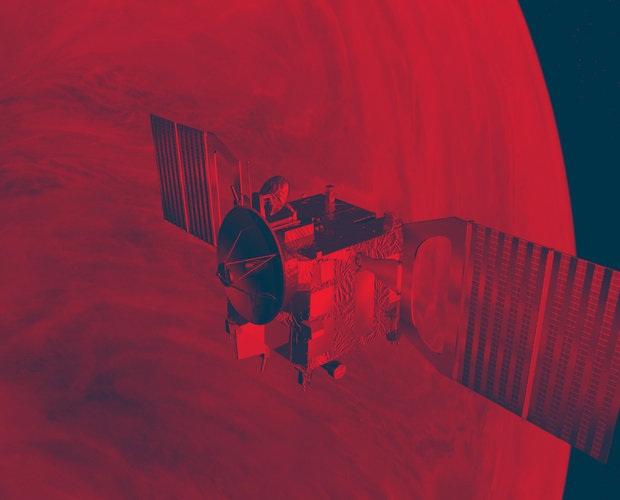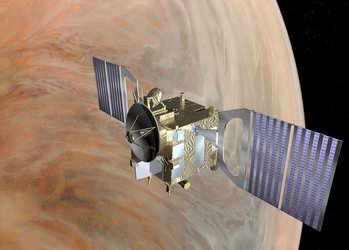Venus Express science highlights
A global investigation of the Venusian atmosphere

Launched 9 November 2005 from Baikonur, Kazakhstan, Venus Express was ESA's first spacecraft to visit Venus. The name "Express" comes from the short time it took to define, prepare and launch the mission – it took just three years from approval to launch and the spacecraft was built in just 33 months.
The mission concluded in 2014.
Thanks to a set of state-of-the-art instruments for planetary investigations, Venus Express dug into the secrets of the Venusian atmosphere. It studied its complex dynamics and chemistry, and the interactions between the atmosphere and the surface, which has given clues about surface’s characteristics.
It also studied the interactions between the atmosphere and the interplanetary environment (solar wind) to better understand the evolution of the planet in the most comprehensive study of the Venusian atmosphere ever.
Key discoveries

- Shape-shifting polar vortices – The existence of the polar vortices on Venus has been known for many years, but high-resolution infrared measurements obtained by the Visible and Infrared Thermal Imaging Spectrometer (VIRTIS) instrument on Venus Express have revealed that the southern vortex is far more complex than previously believed.
- Recent volcanism? – Immediately after arriving at Venus in 2006, the spacecraft recorded a significant increase in the average density of sulphur dioxide in the upper atmosphere, followed by a sharp decrease. One possibility is that the dramatic swing in atmospheric composition was caused by buoyant plumes of volcanic gases released by a large eruption and floating upward.
- Spinning Venus is slowing down – Venus Express discovered that surface features were not quite where they should be, evidence that Earth's cloud-covered neighbour spins a little slower than previously measured.
- Super-rotation is speeding up – After its arrival at the planet in 2006, Venus Express was able to conduct the most detailed survey of cloud motions in the atmosphere of Venus, with the surprising discovery that the planet's high level winds have become faster over time.
- Snow on Venus? – Venus Express discovered a surprisingly cold region high in the planet's atmosphere, where conditions may be frigid enough for carbon dioxide to freeze out as ice or snow.
- Ozone layer – Using observations made with the Spectroscopy for Investigation of Characteristics of the Atmosphere of Venus (SPICAV) instrument, scientists were able to detect the presence of a tenuous layer of ozone gas in its atmosphere.
- Water loss – Venus Express has confirmed that a large quantity of water has been lost into space over billions of years.
- A magnetic surprise – Venus Express has discovered evidence for magnetic reconnection – the process responsible for the Northern Lights on Earth – in Venus' magnetotail.















 Germany
Germany
 Austria
Austria
 Belgium
Belgium
 Denmark
Denmark
 Spain
Spain
 Estonia
Estonia
 Finland
Finland
 France
France
 Greece
Greece
 Hungary
Hungary
 Ireland
Ireland
 Italy
Italy
 Luxembourg
Luxembourg
 Norway
Norway
 The Netherlands
The Netherlands
 Poland
Poland
 Portugal
Portugal
 Czechia
Czechia
 Romania
Romania
 United Kingdom
United Kingdom
 Slovenia
Slovenia
 Sweden
Sweden
 Switzerland
Switzerland





























